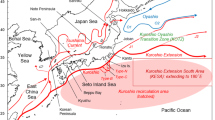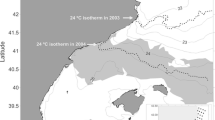Abstract
Since 2007, the ecosystem of the Gulf of Lions has shifted to a different regime, characterised by a low anchovy (Engraulis encrasicolus) and sardine (Sardina pilchardus) biomass and a remarkably high sprat (Sprattus sprattus) biomass. Surprisingly, the abundance and recruitment of anchovy and sardine remained high. To understand which processes (bottom-up or top-down control, etc.) could have caused this shift, we studied the changes in body condition, growth and size and age of anchovy, sardine and sprat over 1984–1985 and 1992–2012, using data from scientific surveys. The annual age structure of anchovy and sardine was estimated using Bayesian mixture models based on size frequency data with priors on the age–length relationship derived from independent otolith readings. The results indicated periods during which anchovy and sardine were in an average (1992–2004), good (2005–2007) or poor (2008–2012) overall state of condition. For sardine, the shift towards smaller fish observed during these past 4 years was explained by a combination of slower growth and the disappearance of older individuals (ages 2+). Despite the increase in biomass of sprat since 2008, indications were found that sprat was also smaller than in the past. As growth and condition decreased and overexploitation has not been documented or suspected for those three species in this area, we propose that the current decline in sardine and anchovy biomass could be due to qualitative and/or quantitative modifications in the planktonic production (i.e. a bottom-up control) or mass mortalities of adults due to an epidemic disease.






Similar content being viewed by others

References
Agostini VN, Bakun A (2002) ‘Ocean triads’ in the Mediterranean Sea: physical mechanisms potentially structuring reproductive habitat suitability (with example application to European anchovy, Engraulis encrasicolus). Fish Oceanogr 11:129–142. doi:10.1046/j.1365-2419.2002.00201.x
Alemany F, Álvarez F (1993) Growth differences among sardine (Sardina pilchardus Walb.) populations in Western Mediterranean. Sci Mar 57:229–234
Bacha M, Amara R (2012) Inter-cohort differences in growth, condition and feeding of juvenile anchovy (Engraulis encrasicolus) in the Gulf of Béjaia (Algerian coast, SW Mediterranean): implications for recruitment success. Fish Res 129–130:73–81. doi:10.1016/j.fishres.2012.06.012
Bakun A (2010) Linking climate to population variability in marine ecosystems characterized by non-simple dynamics: conceptual templates and schematic constructs. J Mar Syst 79:361–373. doi:10.1016/j.jmarsys.2008.12.008
Barange M, Coetzee JC, Twatwa NM (2005) Strategies of space occupation by anchovy and sardine in the southern Benguela: the role of stock size and intra-species competition. ICES J Mar Sci J Cons 62:645–654. doi:10.1016/j.icesjms.2004.12.019
Barange M, Coetzee J, Takasuka A et al (2009) Habitat expansion and contraction in anchovy and sardine populations. Prog Oceanogr 83:251–260. doi:10.1016/j.pocean.2009.07.027
Basilone G, Guisande C, Patti B et al (2004) Linking habitat conditions and growth in the European anchovy (Engraulis encrasicolus). Fish Res 68:9–19. doi:10.1016/j.fishres.2004.02.012
Brehmer P, Guillard J, Guennegan Y et al (2006) Evidence of a variable “unsampled” pelagic fish biomass in shallow water (<20 m): the case of the Gulf of Lion. ICES J Mar Sci 63:444–451. doi:10.1016/j.icesjms.2005.10.016
Brunel T, Piet GJ (2013) Is age structure a relevant criterion for the health of fish stocks? ICES J Mar Sci J Cons 70:270–283. doi:10.1093/icesjms/fss184
Campillo A (1992) Les pêcheries françaises de Méditerranée: synthèse des connaissances. Rapp Internes Dir Ressources Vivantes L’ifremer. p 239
Cardinale M, Casini M, Arrhenius F, Håkansson N (2003) Diel spatial distribution and feeding activity of herring (Clupea harengus) and sprat (Sprattus sprattus) in the Baltic Sea. Aquat Living Resour 16:283–292. doi:10.1016/S0990-7440(03)00007-X
Checkley D, Alheit J, Oozeki Y, Roy C (2009) Climate change and small pelagic fish. Cambridge University Press, New York, p 393
Cury P, Bakun A, Crawford RJM et al (2000) Small pelagics in upwelling systems: patterns of interaction and structural changes in “wasp-waist” ecosystems. ICES J Mar Sci J Cons 57:603–618. doi:10.1006/jmsc.2000.0712
Daskalov GM (2002) Overfishing drives a trophic cascade in the Black Sea. Mar Ecol Prog Ser 225:53–63. doi:10.3354/meps225053
Demaneche S, Merrien C, Berthou P, Lespagnol P (2009) Rapport R3, Méditerranée continentale, échantillonnage des marées au débarquement. Méthode d’élévation et évaluation des captures et de l’effort de pêche des flottilles de la façade Méditerranée continentale sur la période 2007–2008, p 217
Doray M, Masse J, Petitgas P (2010) Pelagic fish stock assessment by acoustic methods at Ifremer, p 18
European Commission (2008) Establishing a framework for community action in the field of marine environmental policy (Marine Strategy Framework Directive). 2008/56/EC: 40
FAO (2014) GFCM Capture Production (online query). Accessed 1 Aug 2013
Fraley C, Raftery EA, Murphy TB, Scrucca L (2012) mclust: normal mixture modeling for model-based clustering, classification, and density estimation. Rpackage version 4.3. http://cran.r-project.org/web/packages/mclust/index.html. Accessed 20 May 2014
Froese R (2006) Cube law, condition factor and weight–length relationships: history, meta-analysis and recommendations. J Appl Ichthyol 22:241–253
Frühwirth-Schnatter S (2008) Finite mixture and markov switching models. Springer, NewYork, p 492
Furnestin J (1948) Observations sur le sprat (Clupea Sprattus Linne) des cotes meridionales de France (Atlantique et Méditerranée). Rev Trav Inst Pech Marit 14:39–69
GFCM (2011) Report of the working group on stock assessment of small pelagic species, p 46
GFCM (2012) Report of the working group on stock assessment of small pelagic species, p 258
Grün B, Leisch F (2013) Flexmix: flexible mixture modeling. R package version 2.3-11. http://cran.r-project.org/web/packages/flexmix/index.html. Accessed 20 May 2014
Harvell CD, Kim K, Burkholder JM et al (1999) Emerging marine diseases—climate links and anthropogenic factors. Science 285:1505–1510. doi:10.1126/science.285.5433.1505
Hunt L, Jorgensen M (1999) Mixture model clustering using the Multimix program. Aust N Z J Stat 41:154–171. doi:10.1111/1467-842X.00071
Jakob EM, Marshall SD, Uetz GW (1996) Estimating fitness: a comparison of body condition indices. Oikos 77:61–67. doi:10.2307/3545585
Jasra A, Holmes CC, Stephens DA (2005) Markov chain Monte Carlo methods and the label switching problem in Bayesian mixture modelling. Stat Sci 20:50–67. doi:10.1214/088342305000000016
Jones JB, Hyatt AD, Hine PM et al (1997) Australasian pilchard mortalities. World J Microbiol Biotechnol 13:383–392. doi:10.1023/A:1018568031621
Kada O, Abdellaoui S, Najih M, Nachite D (2010) Estimation de la croissance de la sardine (Sardina pilchardus Walb., 1792) de la région centro-orientale de la Méditerranée marocaine à l’aide de l’étude des otolithes. Bull L’inst Sci 32:13–15
Laslett GM, Eveson JP, Polacheck T (2004) Fitting growth models to length frequency data. ICES J Mar Sci J Cons 61:218–230. doi:10.1016/j.icesjms.2003.12.006
Le Cren ED (1951) The length–weight relationship and seasonal cycle in gonad weight and condition in the perch (Perca fluviatilis). J Anim Ecol 20:201–219. doi:10.2307/1540
Lee JY (1961) La sardine du golfe du lion (Sardina pilchardus sardina REGAN). Rev Trav Inst Pech Marit 25:418–513
Lee JY, Juge C (1965) Observations morphologiques et biologiques sur anchois (Engraulis encrasicolus) du golfe du Lion. Comm Int Pour Explor Sci Méditerranée Rapp P-V Réun 18:221–224
Macdonald P, Du J (2012) Mixdist: finite mixture distribution models. R package version 0.5-2. http://CRAN.R-project.org/package=mixdist. Accessed 20 May 2014
MEDITS Working Group (2012) MEDITS. International bottom trawl survey in the Mediterranean. Instruction manual. Version 6. Ifremer, France, p 93
Millán M (1999) Reproductive characteristics and condition status of anchovy Engraulis encrasicolus L. from the Bay of Cadiz (SW Spain). Fish Res 41:73–86. doi:10.1016/S0165-7836(99)00010-7
Morales-Nin B, Pertierra JP (1990) Growth rates of the anchovy Engraulis encrasicolus and the sardine Sardina pilchardus in the Northwestern Mediterranean Sea. Mar Biol 107:349–356. doi:10.1007/BF01319836
Oli MK, Dobson S (2003) The relative importance of life-history variables to population growth rate in mammals: Cole’s prediction revisited. Am Nat 161:422–440
Palomera I, Olivar MP, Salat J et al (2007) Small pelagic fish in the NW Mediterranean Sea: an ecological review. Prog Oceanogr 74:377–396. doi:10.1016/j.pocean.2007.04.012
Pauly D, Munro JL (1984) Once more on the comparison of growth in fish and invertebrates. Fishbyte (ICLARM) 2:21
Pertierra JP, Morales-Nin B (1989) Sardine growth in the Catalan Sea (NW Mediterranean) determined by means of otolith interpretation and length frequency data. Sci Mar 53:821–826
Pešić A, Đurović M, Joksimović A et al (2010) Some reproductive patterns of the sardine, Sardina pilchardus (Walb, 1792), in Boka kotorska Bay (Montenegro, southern Adriatic Sea). Acta Adriat 51:159–168
Planque B, Fromentin J-M, Cury P et al (2010) How does fishing alter marine populations and ecosystems sensitivity to climate? J Mar Syst 79:403–417. doi:10.1016/j.jmarsys.2008.12.018
Plounevez S, Champalbert G (2000) Diet, feeding behaviour and trophic activity of the anchovy (Engraulis encrasicolus L.) in the Gulf of Lions (Mediterranean Sea). Oceanol Acta 23:175–192. doi:10.1016/S0399-1784(00)00120-1
R Core Team (2013) R: a language and environment for statistical computing. R Foundation for Statistical Computing, Vienna
Rice J (1995) Food web theory, marine food webs and what climate changes may do to northern marine fish populations. In: Beamish RJ (ed) Clim Change North Fish Popul Canadian Special Publications of Fisheries and Aquatic Sciences, pp 561–568
Ricker WE (1975) Computation and interpretation of biological statistics of fish populations. Bull Fish Res Board Can 191:1–382
Shannon LJ, Cury PM, Jarre A (2000) Modelling effects of fishing in the Southern Benguela ecosystem. ICES J Mar Sci J Cons 57:720–722. doi:10.1006/jmsc.2000.0716
Sinclair M, Iles TD (1989) Population regulation and speciation in the oceans. ICES J Mar Sci 45:165–175. doi:10.1093/icesjms/45.2.165
Sinovčić G, Keč VČ, Zorica B (2008) Population structure, size at maturity and condition of sardine, Sardina pilchardus (Walb., 1792), in the nursery ground of the eastern Adriatic Sea (Krka River Estuary, Croatia). Estuar Coast Shelf Sci 76:739–744. doi:10.1016/j.ecss.2007.07.037
Stahl JT, Oli MK (2006) Relative importance of avian life-history variables to population growth rate. Ecol Model 198:23–39
Stan Development Team (2013) Stan modeling language user’s guide and reference manual, version 2.2.0. p188. http://mc-stan.org/. Accessed 20 May 2014
Stephens M (2000) Dealing with label switching in mixture models. J R Stat Soc Ser B Stat Methodol 62:795–809. doi:10.1111/1467-9868.00265
Tomlinson PK (1971) NORMSEP: normal distribution separation. In: Abramson NJ (ed) Computer programs for fish stock assessment, FAO Fish Tech Pap, FAO, Rome, p 101
Tugores MP, Iglesias M, Díaz N et al (2010) Latitudinal and interannual distribution of the European anchovy (Engraulis encrasicolus) and sardine (Sardina pilchardus) in the western Mediterranean, and sampling uncertainty in abundance estimates. ICES J Mar Sci J Cons 67:1574–1586. doi:10.1093/icesjms/fsq057
Uriarte A, Pouzet P, Villamor B (1996) Bay of Biscay and Ibero Atlantic anchovy populations and their fisheries. Sci Mar 60:237–255
Voulgaridou P, Stergiou KI (2003) Trends in various biological parameters of the European sardine, Sardina pilchardus (Walbaum, 1792), in the Eastern Mediterranean Sea. Sci Mar 67:269–280. doi:10.3989/scimar.2003.67s1269
Zar JH (1999) Biostatistical analysis, 5th edn. Pearson Prentice-Hall, New York
Acknowledgments
We thank the captain and the crew of the RV “L’Europe” and RV “Thalassa” as well as all the scientists on board for their assistance during the PELMED surveys. We thank the two anonymous reviewers for their careful review of the manuscript and their excellent suggestions. PELMED surveys are cofinanced by Europe through the Data Collection Framework. We also thank the MEDITS team and the fishermen working with “contrats bleus” to provide us with samples for otolith analyses. This work is a part of the programme EcoPelGol (Study of the Pelagic ecosystem in the Gulf of Lions), financed by France Filière Pêche (FFP).
Author information
Authors and Affiliations
Corresponding author
Additional information
Communicated by K. D. Clements.
Electronic supplementary material
Below is the link to the electronic supplementary material.
Rights and permissions
About this article
Cite this article
Van Beveren, E., Bonhommeau, S., Fromentin, JM. et al. Rapid changes in growth, condition, size and age of small pelagic fish in the Mediterranean. Mar Biol 161, 1809–1822 (2014). https://doi.org/10.1007/s00227-014-2463-1
Received:
Accepted:
Published:
Issue Date:
DOI: https://doi.org/10.1007/s00227-014-2463-1



